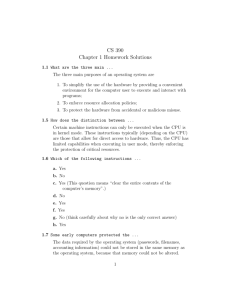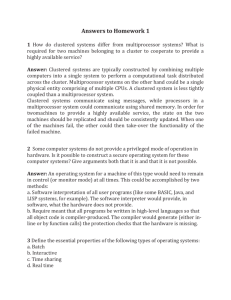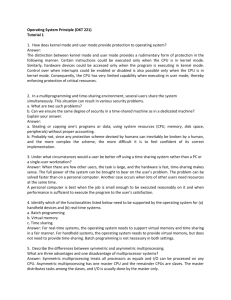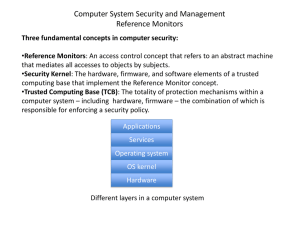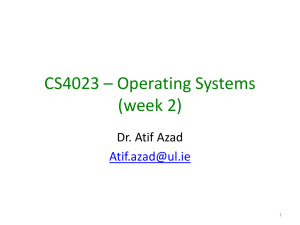Answers to Selected Exercises
advertisement
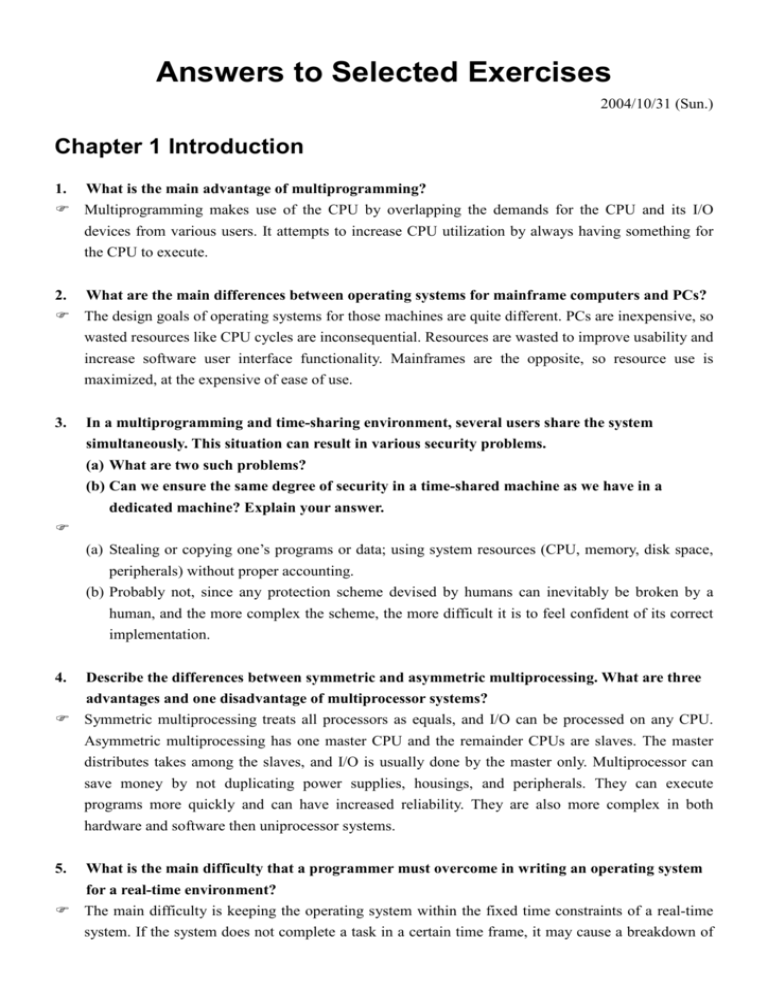
Answers to Selected Exercises 2004/10/31 (Sun.) Chapter 1 Introduction 1. What is the main advantage of multiprogramming? Multiprogramming makes use of the CPU by overlapping the demands for the CPU and its I/O devices from various users. It attempts to increase CPU utilization by always having something for the CPU to execute. 2. What are the main differences between operating systems for mainframe computers and PCs? The design goals of operating systems for those machines are quite different. PCs are inexpensive, so wasted resources like CPU cycles are inconsequential. Resources are wasted to improve usability and increase software user interface functionality. Mainframes are the opposite, so resource use is maximized, at the expensive of ease of use. 3. In a multiprogramming and time-sharing environment, several users share the system simultaneously. This situation can result in various security problems. (a) What are two such problems? (b) Can we ensure the same degree of security in a time-shared machine as we have in a dedicated machine? Explain your answer. (a) Stealing or copying one’s programs or data; using system resources (CPU, memory, disk space, peripherals) without proper accounting. (b) Probably not, since any protection scheme devised by humans can inevitably be broken by a human, and the more complex the scheme, the more difficult it is to feel confident of its correct implementation. 4. Describe the differences between symmetric and asymmetric multiprocessing. What are three advantages and one disadvantage of multiprocessor systems? Symmetric multiprocessing treats all processors as equals, and I/O can be processed on any CPU. Asymmetric multiprocessing has one master CPU and the remainder CPUs are slaves. The master distributes takes among the slaves, and I/O is usually done by the master only. Multiprocessor can save money by not duplicating power supplies, housings, and peripherals. They can execute programs more quickly and can have increased reliability. They are also more complex in both hardware and software then uniprocessor systems. 5. What is the main difficulty that a programmer must overcome in writing an operating system for a real-time environment? The main difficulty is keeping the operating system within the fixed time constraints of a real-time system. If the system does not complete a task in a certain time frame, it may cause a breakdown of the entire system it is running. Therefore when writing an operating system for a real-time system, the writer must be sure that his scheduling schemes don’t allow response time to exceed the time constraint. Chapter 2 Computer-System Structure 1. What are the differences between a trap and an interrupt? What is the use of each function? An interrupt is a hardware-generated change-of-flow within the system. An interrupt handler is summoned to deal with the cause of the interrupt; control is then returned to the interrupted context and instruction. A trap is a software-generated interrupt. An interrupt can be used to signal the completion of an I/O to obviate the need for device pooling. A trap can be used to call operating system routines or to catch arithmetic errors. 2. For what types of operations is DMA useful? Explain your answer. DMA is useful for transferring large quantities of data between memory and devices. It eliminates the need for the CPU to be involved in the transfer, allowing the transfer to complete more quickly and the CPU to perform other tasks concurrently. 3. Which of the following instructions should be privileged? (a) Set value of timer. (b) Read the clock. (c) Clear memory. (d) Turn off interrupts. (e) Switch from user to monitor mode. (a), (c), (d) 4. Some computer systems do not provide a privileged mode of operation in hardware. Is it possible to construct a secure operating system for these computers? Give arguments both that it is and that it is not possible. An operating system for a machine of this type would need to remain in control(or monitor mode) at all times. This could be accomplished by two methods: (a) Software interpretation of all user programs (like some BASIC, APL, and LISP systems, for example). The software interpreter would provide, in software, what the hardware does not provide. (b) Require meant that all programs be written in high-level languages so that all object code is compiler-produced. The compiler would generate (either in-line or by function calls) the protection checks that the hardware is missing. 5. Give two reasons why caches are useful. What problems do they solve? What problems do they cause? If a cache can be made as large as the device for which it is caching (for instance, a cache as large as a disk), why not make it that large and eliminate the device? Caches are useful when two or more components need to exchange data, and the components perform transfers at different speeds. Caches solve the transfer problem by providing a buffer of intermediate speed between the components. If the fast device finds the data it needs in the cache, it need not wait for the slower devices. The data in the cache must be kept consistent with the data in the components. If a component has a data value change, and the datum is also in the cache, the cache must also be updated. This is especially a problem on multiprocessor systems where more than one process may be accessing a datum. A component may be eliminated by an equal-sized cache, but only it: (a) the cache and the component have equivalent state-saving capacity (that is, if the component retains its data when electricity is removed, the cache must retain data as well), and (b) the cache is affordable, because faster storage tends to be more expensive. Chapter 3 Operating-System Structures 1. What is the purpose of the command interpreter? Why is it usually separate from the kernel? It reads commands from the user or from a file of commands and executes them, usually by turning them into one or more system calls. It is usually not part of the kernel since the command interpreter is subject to changes. 2. What is the main advantage of the microkernel approach to system design? Benefits typically include the following (a) adding a new service does not require modifying the kernel, (b) it is more secure as more operations are done in user mode than in kernel mode, and (c) a simpler kernel design and functionality typically results in a more reliable operating system. 3. What is the main advantage for an operating-system designer of using a virtual-machine architecture? What is the main advantage for a user? The system is easy to debug, and security problems are easy to solve. Virtual machines also provide a good platform for operating system research since many different operating systems may run on one physical system. 4. Why is a just-in-time compiler useful for executing Java programs? Java is an interpreted language. This means that the JVM interprets the byte-code instructions one at a time. Typically, most interpreted environments are slower than running native binaries, for the interpretation process requires converting each instruction into native machine code. A just-in-time(JIT) compiler compiles the bytecode for a method into native machine code the first time the method is encountered. This means that the Java program is essentially running a native application (of course, the conversion process of the JIT takes time as well but not as much as bytecode interpretation.) Furthermore, the JIT caches compiled code so that it may be reused the next time the method is encountered. A Java program that is run by a JIT rather a traditional interpreter typically runs much faster. 5. Why is the separation of mechanism and policy a desirable principle? Mechanism and policy must be separate to ensure that systems are easy to modify. No two system installations are the same, so each installation may want to tune the operating system to suit its needs. With mechanism and policy separate, the policy may be changed at will while the mechanism stays unchanged. This arrangement provides a more flexible system. Chapter 4 Processes 1. MS-DOS provided no means of concurrent processing. Discuss three major complications that concurrent processing adds to an operating system. (a) A method of time sharing must be implemented to allow each of several processes to have access to the system. This method involves the preemption of processes that do not voluntarily give up the CPU (by using a system call, for instance) and the kernel being reentrant(so more than one process may be executing kernel code concurrently.) (b) Processes and system resources must have protections and must be protected from each other. Any given process must be limited in the amount of memory it can use and the operations it can perform on devices like disks. (c) Care must be taken in the kernel to prevent deadlocks between processes, so processes aren’t waiting for each other’s allocated resources. 2. Describe the differences among short-term, medium-term, and long-term scheduling. (a) Short-term (CPU scheduler) – selects from among the processes that are ready to execute and allocates CPU to them. (b) Medium-term – used especially with time-sharing systems as an intermediate scheduling level. A swapping scheme is implemented to remove partially run programs from memory and reinstate them later to continue where they left off. (c) Long-term (job scheduler) – determines which jobs are brought into memory for processing. The primary difference is in the frequency of their execution. The short-term must select a new process quite often. Long-term is used much less often since it handles placing jobs in the system and may wait for a job to finish before it admits another one. 3. Describe the actions taken by a kernel to switch context between processes. In general, the operating system must save the state of the currently running process and restore the state of the process scheduled to be run next. Saving the state of a process typically includes the values of all the CPU registers in addition to memory allocation. Context switches must also perform many architecture-specific operations, including flushing data and instruction caches. 4. The correct producer-consumer algorithm in Section 4.4 allows only n-1 buffers to be full at any one time. Modify the algorithm to allow all buffers to be utilized fully. Please refer to Section 7.1


